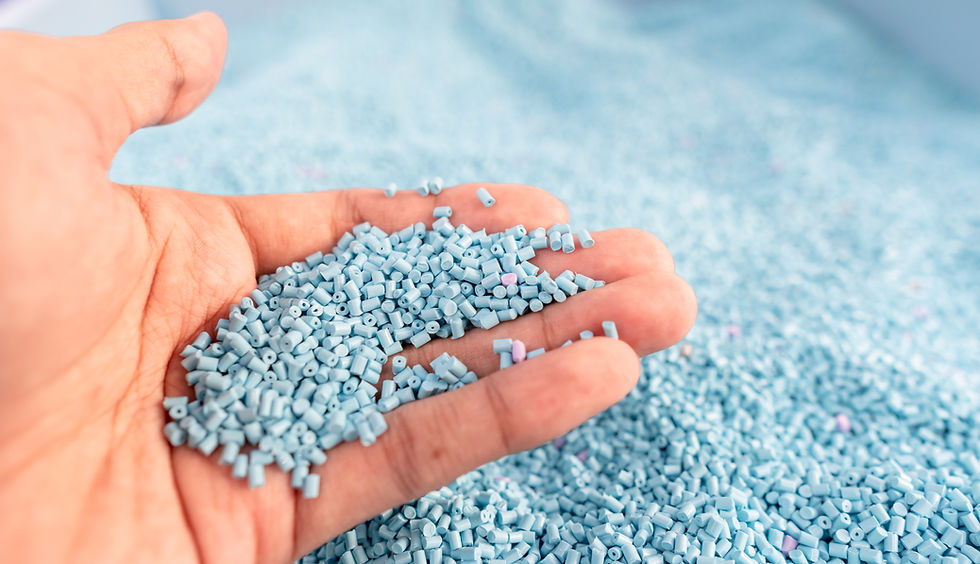Microplastics: Should You Be Worried?
- Noël King
- Mar 24
- 3 min read
Updated: Jun 7

Microplastics have rapidly emerged as a central concern in recent discussions about environmental contamination and public health. I will do several posts informing you about the ways these tiny plastic particles, which measure less than 5 millimeters which is about the size of a pencil eraser, have now been discovered in every corner of our planet, including the ocean depths as well as our food supply, the air we inhale, and our bodies. The origins of microplastics remain unclear, but their widespread presence raises questions about their emergence as a significant problem. We need first to explore the beginnings and development of this worldwide challenge.
What Are Microplastics?
Microplastics represent tiny plastic fragments that emerge from the breakdown of more oversized plastic objects or as deliberate manufacturing components in items like personal care products.
The issue begins with synthetic microbeads from personal care products representing primary microplastics.
Secondary microplastics form when larger plastic objects such as bags, bottles, and fishing nets degrade through exposure to sunlight combined with wind and water movement.
Although the concept of "microplastics" is new, this problem has been developing for decades.
The invention of plastic brought forth both synthetic materials and the initial stages of microplastic pollution.
Early 1900s: In 1907, the development of synthetic plastic started with materials such as Bakelite. The first synthetic plastics produced in this era offered durability and low cost, making them perfect for industrial applications and consumer products.
1940s–50s: Plastic production surged dramatically during the post-World War II economic boom. The emergence of disposable culture made plastic a standard in homes.
1960s: Plastics began showing up in the oceans. A scientific publication from 1972 documented the presence of plastic fragments in the Sargasso Sea as one of the first known studies of marine plastic pollution.
The Term “Microplastics” Is Coined
2004: British marine biologist Dr. Richard Thompson introduced the term microplastics. The journal "Science" published his groundbreaking research showing microscopic plastic particles commonly appear in ocean sediment and beach sand.
At this time, scientists started recognizing microplastics as a significant consequence of plastic pollution, which had previously received little attention.
Sources of Microplastics: Where Are They Coming From?
Microplastics originate from a variety of sources:
During washing, synthetic textiles such as polyester and nylon release tiny fibers.
The abrasion of car tires on roads generates microplastic dust particles.
Cosmetic products once contained microbeads for exfoliation.
Over time, plastic debris from packaging turns into smaller particles.
Existing wastewater treatment facilities cannot remove these particles, which flow into rivers, lakes, and oceans.
Single-use water bottles
Global Spread and Growing Awareness
From the 2010s to the present, Scientists have found microplastics in Earth's most isolated parts, including Arctic ice sheets, mountain summits, and deep oceanic trenches. Research has revealed the presence of microplastics in drinking water and seafood, as well as in salt and inside human blood and lungs.
Policy Changes: The United States and the UK have prohibited the use of plastic microbeads in personal care products. The European Union actively develops comprehensive regulations to address the origin of microplastic pollution.
The Big Picture: Why Microplastics Matter
Beyond environmental dangers, microplastics represent direct threats to animal welfare and human health. Marine animals consume microplastics under the false impression that they are food, which leads to harm or mortality and raises the issue of plastic contamination in the food chain. Scientists continue to research the long-term health effects of microplastic exposure in humans, which present significant concerns.
Conclusion
Microplastics, based on my current research, are not ubiquitous pieces of matter. Microplastics produce significant and widespread effects. As the 20th century saw a rise in plastic usage due to convenience needs, their existence has expanded rapidly yet quietly. We started to understand the accurate scale of the problem just within the last twenty years and remain behind in our understanding.
I think we should, at a minimum, be concerned and begin to take steps to minimize exposure. I do not believe it is possible to undo decades of plastic pollution in one day or ever. However, I do think it is possible to minimize its effects greatly. I will do my best to enhance your awareness of microplastics so you can make informed decisions about what to do.
Thanks for being here.
Blessings
"There are billions of items of plastic waste in our streams, rivers, lakes, and oceans. To put it into perspective, there are more microplastics in the ocean than there are stars in the Milky Way! " IBSS Corporation




Comments